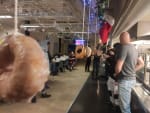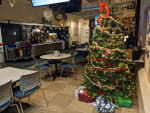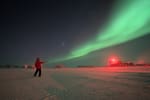IceCube collaborator Lu Lu received a 2023 International Union of Pure and Applied Physics (IUPAP) Early Career Scientist Prize “for her contributions to the development of high energy neutrino astronomy in the PeV energy region.” Lu accepted the award on July 27 during the opening ceremony at the 38th International Cosmic Ray Conference (ICRC) held […]
News
IceCube search for neutrino emission from extended sources in the galactic plane
The sources of cosmic rays—extremely energetic particles that rain down on Earth—have been a long-standing mystery in the field of astronomy. Cosmic-ray accelerators in the PeV energy range, known as PeVatrons, produce pions when the cosmic rays interact with their surroundings. These pions then decay into gamma rays and nearly massless particles called neutrinos. These […]
Week 28 at the Pole
Christmas in July continued last week with all sorts of activities, ranging from a pool tournament to a pie-eating contest. And for those who enjoy competitive eating, they weren’t limited to just pies—a “donuts on a string” eating contest was also part of the festivities. In addition, the station held a Christmas trivia night and […]
Week 27 at the Pole
A barren landscape, the South Pole is actually a desert. It’s not the kind of desert most people imagine, with lots of sand and heat and maybe a camel ambling by. Instead of sand, there’s snow. But almost all of that snow has blown in from more coastal regions of the continent, ushered in from […]
Week 26 at the Pole
Not everyone celebrates Christmas in July, but they do at the South Pole station, where traditions prevail. Last week started off the festivities with the appearance of a tree and presents in the galley. More activities and decorations are planned for upcoming weeks. The weather was nice and cold as a fitting complement to the […]
Our galaxy seen through a new lens: neutrinos detected by IceCube
Our Milky Way galaxy is an awe-inspiring feature of the night sky, viewable with the naked eye as a horizon-to-horizon hazy band of stars. Now, for the first time, the IceCube Neutrino Observatory has produced an image of the Milky Way using neutrinos—tiny, ghostlike astronomical messengers. In an article to be published tomorrow, June 30, […]
Week 25 at the Pole
For those who spend a year living at the South Pole, they are treated to glorious night skies in the winter season. Last week was a case in point, with displays of bright auroras, lots of stars, and glimpses of the Milky Way. Winterovers also get to experience a multitude of South Pole station traditions […]
Week 24 at the Pole
Last week at the Pole it was all about the sky. There were days with perfectly clear skies and some of the brightest auroras of the season. If the photo above seems to suggest a little wizardry action behind the aurora, it might be a result of watching too much Harry Potter—the station organized a […]
Week 23 at the Pole
It’s getting close to midwinter, when people in Antarctica, and other places, celebrate the southern winter solstice. In anticipation, South Pole station personnel took some group photos (above is one of them) to use as midwinter greeting cards, traditionally shared with other Antarctic stations. Last week at the Pole, IceCube’s winterovers spent a lot of […]









